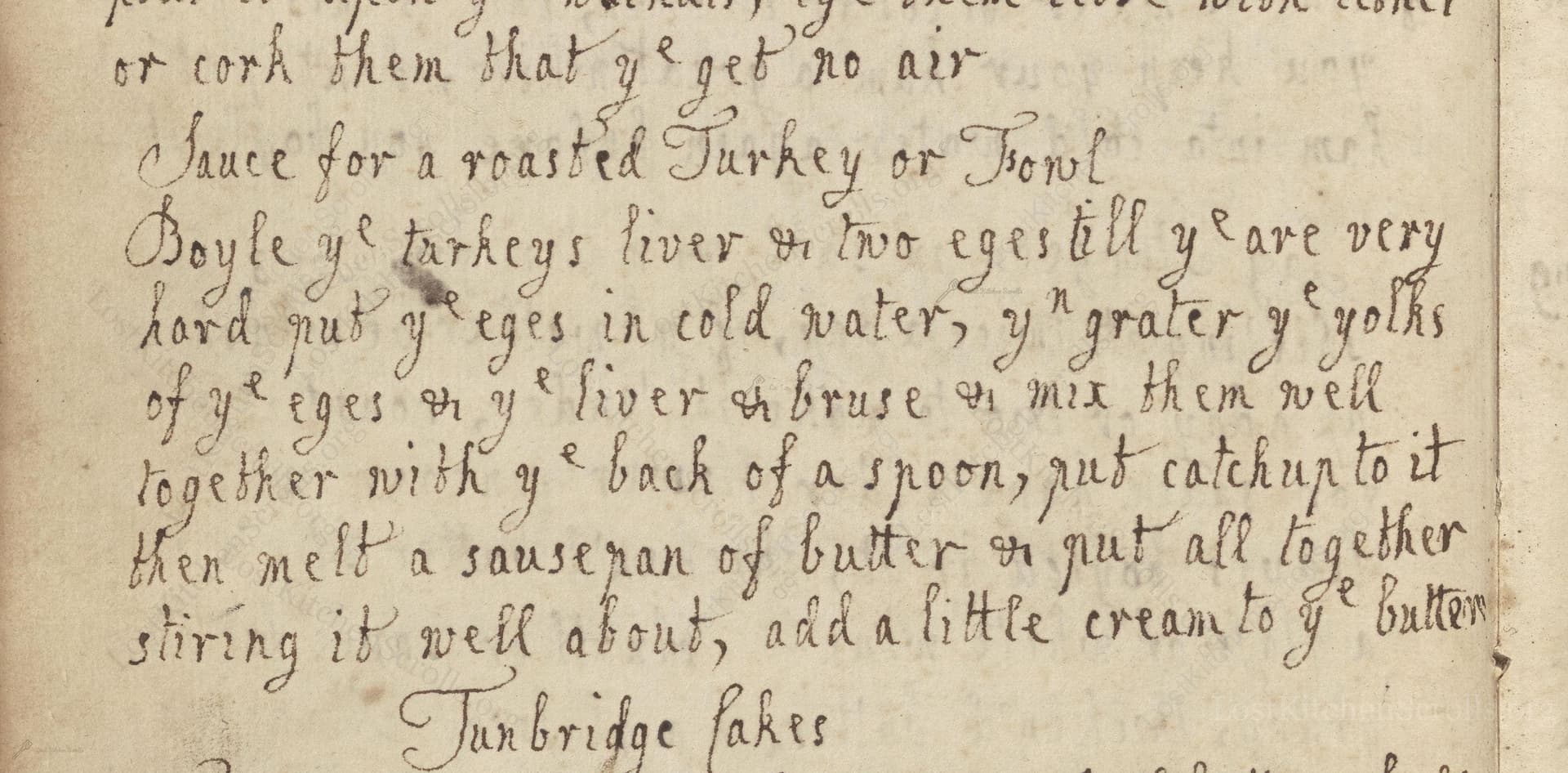
Sauce For A Roasted Turkey Or Fowl
"Boyle ye turkeys liver or two eges till ye are very hard put ye eges in cold water, yn grater ye yolks of ye eges or ye liver or bruse or mix them well together with ye back of a spoon, put catchup to it then melt a sausepan of butterr or put all together stiring it well about, add a little cream to ye butterr"
Note on the Original Text
Recipes from this period were written in a brief, almost shorthand style. They assume the cook's familiarity with common ingredients and methods—there are no timings or precise measurements, and actions like 'put in cold water' refer to common kitchen practices of the day. Spelling reflects early 18th-century English ('ye' for 'the', 'bruse' for 'bruise', and 'eges' for 'eggs'), and punctuation was often absent or inconsistent. Ingredients like 'catchup' refer not to the tomato variety but to mushroom ketchup, a popular British condiment of the era.

Title
Cookbook of 1720 (1720)
You can also click the book image above to peruse the original tome
Writer
Unknown
Era
1720
Publisher
Unknown
Background
Step back to the early 18th century and discover a delightful treasury of recipes and culinary secrets, where traditional flavors meet timeless technique—a feast for curious cooks and history lovers alike.
Kindly made available by
Folger Shakespeare Library
This recipe dates from around 1720 in England, a time when sauces for roasted meats were often a luxurious feature at the table, with creamy textures and savory, umami notes from ingredients like mushroom ketchup. The use of offal, such as the liver, was common in early 18th-century kitchens, ensuring no part of the bird went to waste. Mushroom ketchup was a quintessential umami seasoning before the invention of Worcestershire sauce, revealing early English tastes for savory flavors long before 'umami' was a commonly known term.

Historically, this sauce would be prepared with a small saucepan or skillet—often made of copper or pewter—heated over an open hearth or a small coal fire. A grater or the back of a large wooden spoon would be used to mash the yolks or liver to a fine consistency. A strong arm and a steady hand were necessary for the stirring and emulsifying, as kitchen gadgets and mixers were centuries in the future.
Prep Time
7 mins
Cook Time
10 mins
Servings
2
We've done our best to adapt this historical recipe for modern kitchens, but some details may still need refinement. We warmly welcome feedback from fellow cooks and culinary historians — your insights support the entire community!
Ingredients
- 1 turkey liver (about 2 oz), or 2 large eggs (approx. 4 oz total, if liver unavailable)
- 1–2 tablespoons (0.5–1 fl oz) mushroom ketchup (sub: mushroom soy sauce or Worcester sauce)
- 3 1/2 tablespoons (1/2 stick, 2 oz) unsalted butter
- 2 tablespoons (1 fl oz) double cream
- Salt and pepper, to taste (optional)
Instructions
- Begin by boiling the turkey's liver (or, if unavailable, two large eggs) until they are firm—about 10 minutes for eggs, slightly less for a liver.
- Cool the eggs in cold water, then peel.
- Grate the cooked yolks or finely mash the liver with the back of a spoon, blending them to a smooth paste.
- Add about 1–2 tablespoons of mushroom ketchup or a modern mushroom soy sauce as a substitute.
- In a small saucepan, melt 3 1/2 tablespoons (1/2 stick) of butter over low heat, then add the egg or liver mixture, stirring continuously.
- Add a splash (about 2 tablespoons) of double cream to the saucepan, and keep stirring until the sauce is heated through and smooth.
- Season lightly with salt and pepper if desired.
- Serve warm as an accompaniment to roast turkey or fowl.
Estimated Calories
170 per serving
Cooking Estimates
It takes about 10 minutes to boil the eggs or liver, and a few minutes to prepare the other ingredients. This recipe makes about 2 servings and each serving has around 170 calories.
As noted above, we have made our best effort to translate and adapt this historical recipe for modern kitchens, taking into account ingredients nowadays, cooking techniques, measurements, and so on. However, historical recipes often contain assumptions that require interpretation.
We'd love for anyone to help improve these adaptations. Community contributions are highly welcome. If you have suggestions, corrections, or cooking tips based on your experience with this recipe, please share them below.
Join the Discussion
Rate This Recipe
Dietary Preference

Den Bockfisch In Einer Fleisch Suppen Zu Kochen
This recipe hails from a German manuscript cookbook compiled in 1696, a time whe...

Die Grieß Nudlen Zumachen
This recipe comes from a rather mysterious manuscript cookbook, penned anonymous...

Ein Boudain
This recipe comes from an anonymous German-language manuscript cookbook from 169...

Ein Gesaltzen Citroni
This recipe, dating from 1696, comes from an extensive anonymous German cookbook...
Browse our complete collection of time-honored recipes



